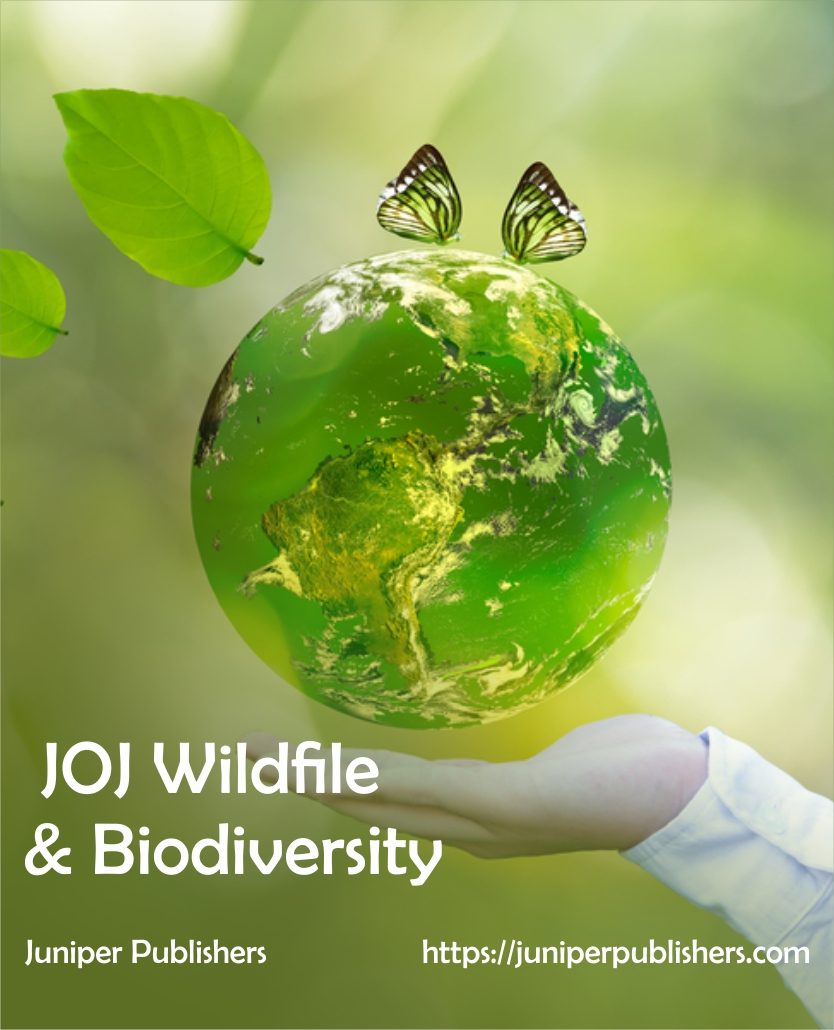Carnivorous Plants of Texas
Brian Loflin*
Department of Rangeland and Wildlife Sciences, Texas A&M University-Kingsville, US
Submission: June 28, 2021; Published: July 15, 2021
*Corresponding author: Brian Loflin, Department of Rangeland and Wildlife Sciences, Texas A&M University-Kingsville, US
How to cite this article: Brian L. Carnivorous Plants of Texas. JOJ Wildl Biodivers. 2021: 4(1): 555626. DOI: 10.19080/JOJWB.2021.04.555626
Quotation
During the summer of 1860. I was surprised by finding how large a number of insects were caught by the leaves of the common sun-dew [sic]… I had heard that insects were thus caught but knew nothing further on the subject. -Charles Darwin, 1875.
Keywords: Pitcher plant; Piney woods; Carnivorous plants; Insectivorous plants
Mini Review
This article begins with a misnomer, or misconception, if you wish. The plants described herein, while carnivorous in the most general sense, should perhaps be labeled insectivorous in a more specific sense. Found in soils that are generally poor in nutrients for most plants, this group of plants has adapted by developing mechanisms that allow for the capture and subsequent digestion of small insects that become trapped by the plant. There are several trapping mechanisms found within these most interesting plants and this review will document several. Surprisingly, in Texas there are four of the five North American carnivorous plants. These include the largest and showy Pitcher Plants (Saracenia), Sundew (Drosera), Butterworts (Penquicula), and Bladderworts (Utricularia). Missing in Texas is the most curious Venus Flytrap (Dionaea), found only in the Carolinas. (Figure 1) Unlike the open, arid lands commonly found in Texas, the Piney Woods vegetative area of East Texas comprises an area of some 16 million acres and is the far western edge of North Americas’ great southeastern forest. Here, along the border with Louisiana, the region receives 40 to 56 inches annual rainfall, more than anywhere else in the state. Therefore, many rivers, creeks, and bayous drain the region. Most of this area ranges from about 50 to 700 feet above sea level where the weather is temperate, and the soils are conducive to amazing plant growth. The Piney Woods is predominantly a coniferous forest with three native species of pine: longleaf, shortleaf, and loblolly. An introduced species, the slash pine, is also widely grown. Hardwoods include oaks, elm, hickory, magnolia, sweet and black gum, tupelo, and others. I have recently been increasingly interested in an unusual group of plants found in East Texas-- carnivorous plants. Of the five types found in the U. S., Texas has four, but found almost exclusively in the big woods of that area. The many wetlands and bogs give rise to several of these very special plants. The plants include the large and showy Pitcher Plants, the hard-to-find, floating Bladderwort, the obscure Butterwort, and the diminutive Sundew. A fifth, more well-known carnivorous plant, the Venus Fly Trap, is found only in the Carolinas. In reality, these plants are more specifically insectivorous vs. carnivorous in the strictest sense. Found in nutrient-poor soils that are particularly lacking in nitrogen, these plants absorb food from trapping insects and absorbing the much-needed nutrients that are missing from the habitat. It is this mechanism that I am now most interested in. The mechanisms involved include leaves that are modified in the form of traps. The trapping mechanisms are designated as active or passive depending upon whether they move to capture the prey or not. The different types of traps found in insectivorous plants in Texas are passive and include pitfall traps, found in the pitcher plant. They have a hollow and funnel-shaped modified leaf with a lid that is filled with liquid to digest the prey. As the name implies, flypaper traps are sticky and adhesive. The leaves are covered in stalked glands that secrete sticky mucilage that captures an unsuspecting insect. In Texas flypaper traps include Sundew and Butterwort. Bladderwort traps are commonly found in Utricularia. Somewhat active, they have many tiny underwater tissue bladders that when an insect touches trigger hairs it instantly creates a partial vacuum or negative internal pressure to suck in the small organisms. In the past, I have photographed many plants before. But that photography, except with cacti, consisted largely of images of the showy part--the flowers. Therefore, in the past, my photographs have been mostly flower or plant portraits. Those images neither show much about the nature story or what the plant does, nor their relationships with others. I wanted to change my focus more on the story rather than pretty portraits. With these plants, I wanted to concentrate on the mechanism and illustrate the tiny structures that enable trapping and absorbing insects. So, in order to capture photographically this capture mechanism in detail, I have worked on ways to get my camera and flash on the ground and with enough magnification from 1:1 life size to 10X life size to get the details needed to see these tiny structures. The following is a review of these most-interesting plants with their images.
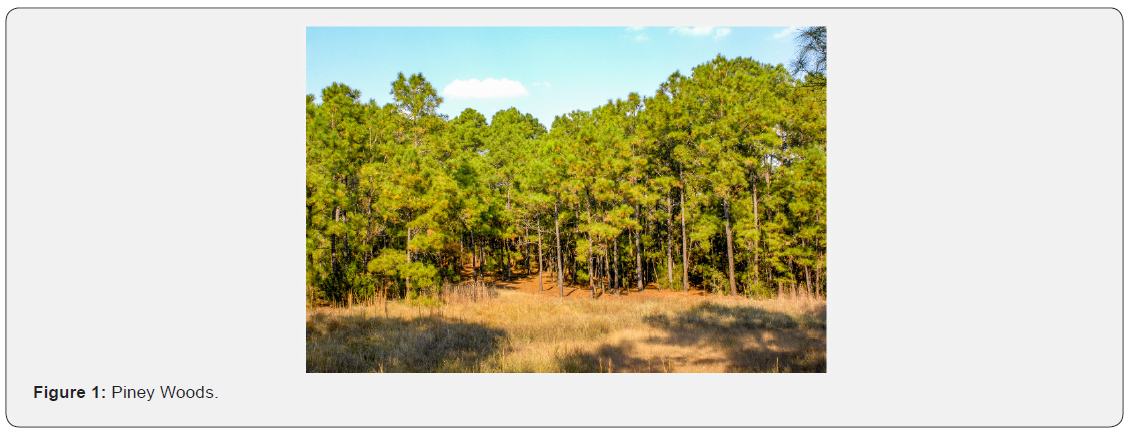
Pitcher Plants (Saracenia alata)
The most obvious of the insectivorous plants is the Pitcher plant, Saracenia alata, a strikingly tall perennial plant with specially modified leaves that form the “pitcher”. Due to life in nutrient poor soils, pitcher plants obtain most of their nutritional needs from the fluids and soft body parts of the insects they are able to consume.
(Figure 2) A bog area in the East Texas Piney Woods, home to many carnivorous plants, including Pitcher Plants, Butterworts, and Sundews.
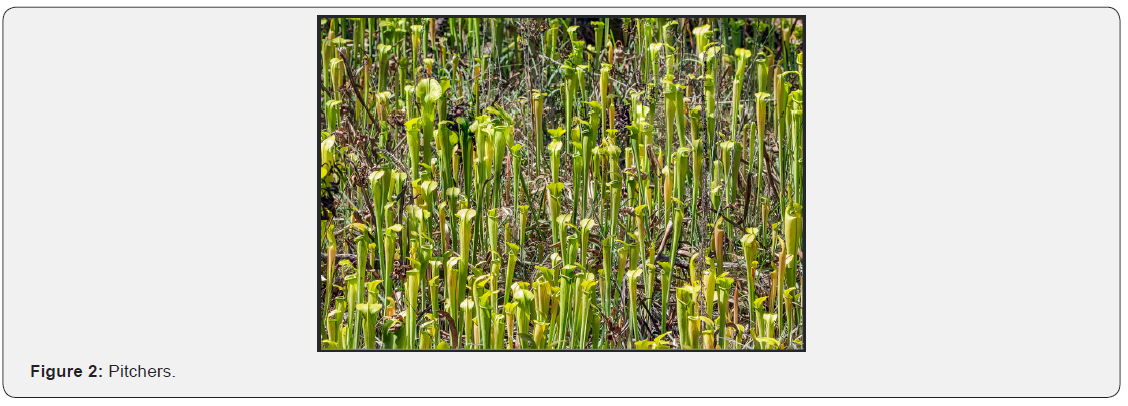
(Figure 3) Rising like hooded cobras, pitcher plants are the largest and most showy of the insectivorous plants. The pitchers are modified leaves and, along with surrounding leaves, stand sometimes two feet tall. These modified leaves create the “pitcher” by rolling up like a funnel, collecting water and insects that fall into the trap to be digested and used as plant nutrients.
(Figure 4) A mature flower of a pitcher plant hangs at the tip of a leafless stem. It has three bracts, five sepals, five petals, and many stamens and appears like an upside-down umbrella.
(Figure 5) This image shows reddish seed pods forming on the pitcher plant flower.
Apart from the persistent leaves and more obvious pitcher, the flower (upper right) of the plant is found in spring and is responsible for reproduction. The edges of the pitcher are smooth and covered in a slick substance that cause visiting insects to fall into the bottom of the funnel. The insects land in a pool of digestive enzymes that effectively dissolve the insect and absorb the resulting nutrients into the plant.
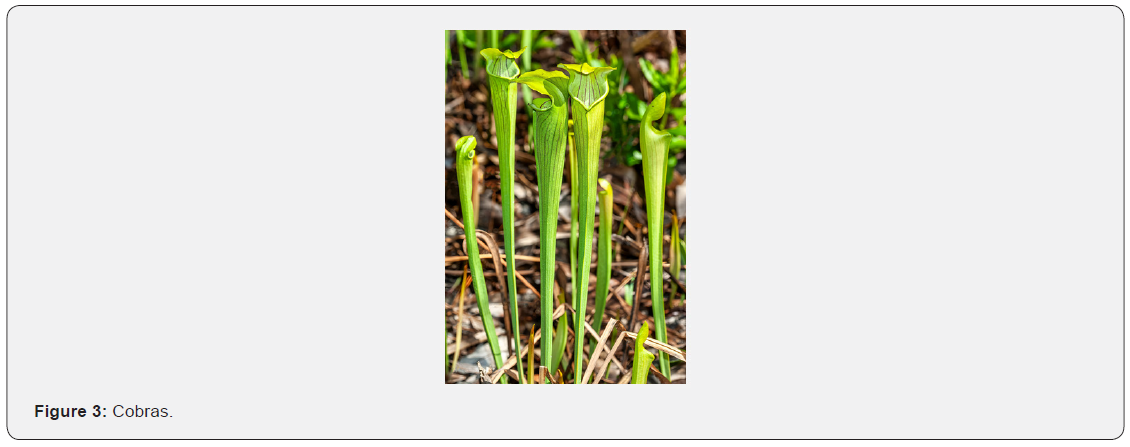
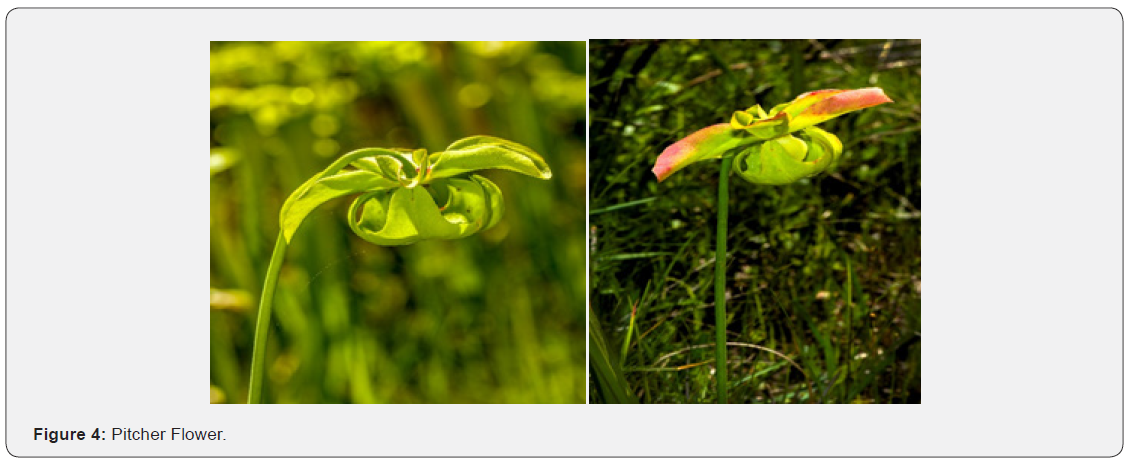

(Figure 6) In this image an ant is walking along the lip of the pitcher at its peril.
(Figure 7) The upper lid and lip of the pitcher has a slippery surface with very small nectar-secreting pores that attract insects to the edge. As an insect enjoys the sweet nectar, it often loses footing and slides into the bottom of the funnel where the plant’s digestive juices help to dissolve the insect to allow the absorption of the insect’s nutrient.

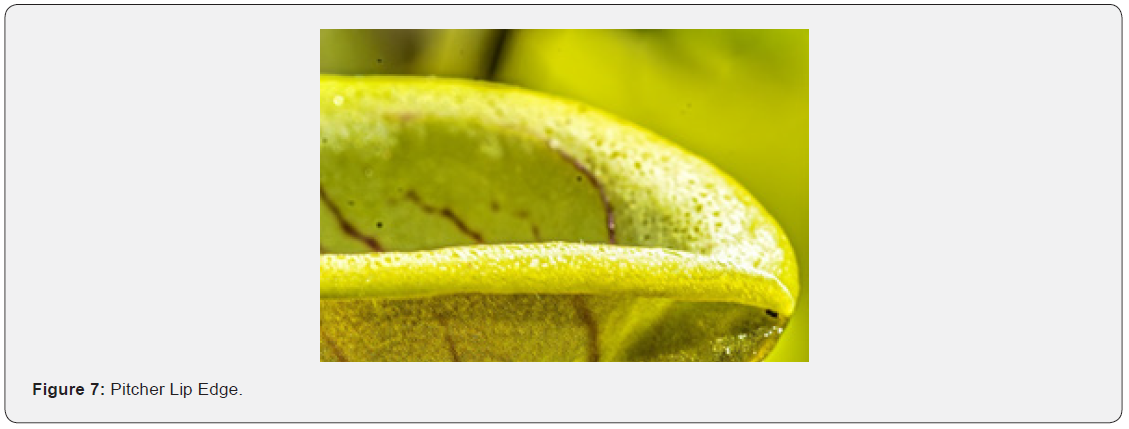
Sundew (Drosera sp.)
Another carnivorous species that is much smaller and somewhat more difficult to find is the Sundew, one of the favorite insectivorous plants of early botanist/naturalist Charles Darwin. Two species are found in East Texas, the green, Spoon-leaf Sundew, Drosera intermedia and Pink Sundew, D. capillaris.
(Figure 8-10) The small sundews lay flat on the ground and the pink leaf structures seen here are about the size of a quarter. When in flower, the tiny blossom rises on a single stem about three inches above the plant.
These perennial plants are small herbs that have leaves with tentacle-like stalks with a mucilaginous secretory gland at the tip of each stalk. The gland secretes droplets of fluid which gives the plant its glistening, dew-drop appearance. Insects, upon being attracted to the plant through the nectar-like appearance and odor of the secretions, become stuck to the mucilage. Once the plant senses the insect struggling, it slowly encloses the insect in the array of tentacles. A digestive enzyme then is released to break down the insect into usable nutrients.
(Figure 11) As can be visualized in this macro image, the plant’s modified leaves have many tiny hair-like structures tipped with a sticky substance that will act like fly paper, holding the insect until the leaf pad curls around the insect so the nutrients may be absorbed. You can see a curled pad close to the left margin of this photo.
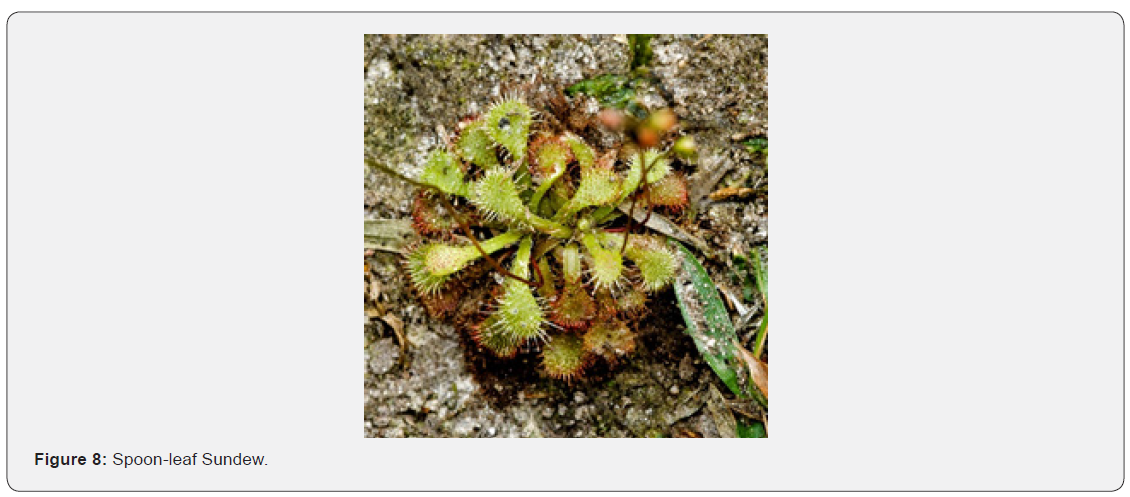
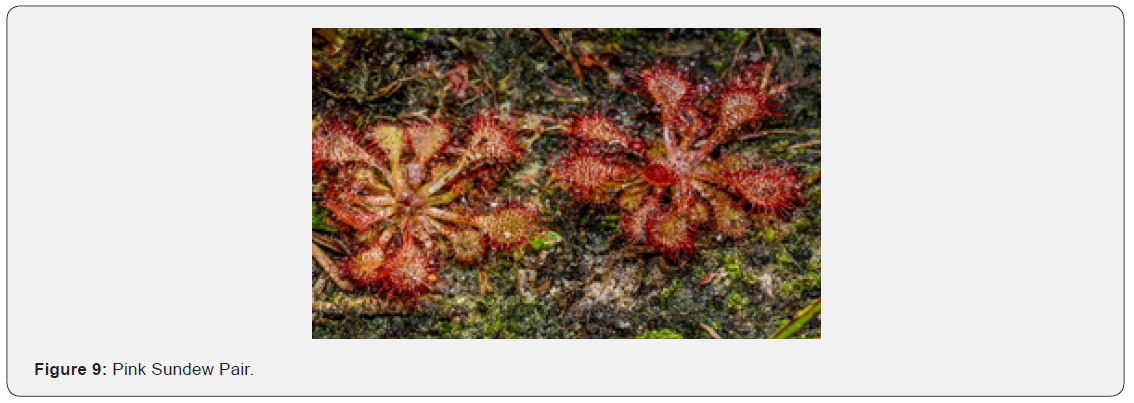
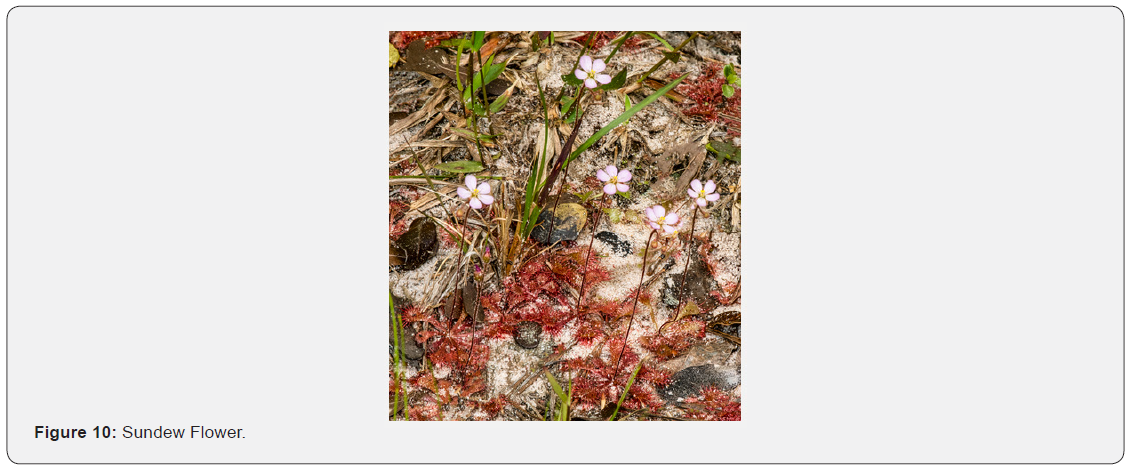
(Figure 12) One section of the modified leaf shows the tiny hair structures with the tentacle glands where its drop of sticky-mucilaginous secretion is produced.
(Figure 13) Details of the glandular tissue bulb at the end of the tentacles (image 10x).
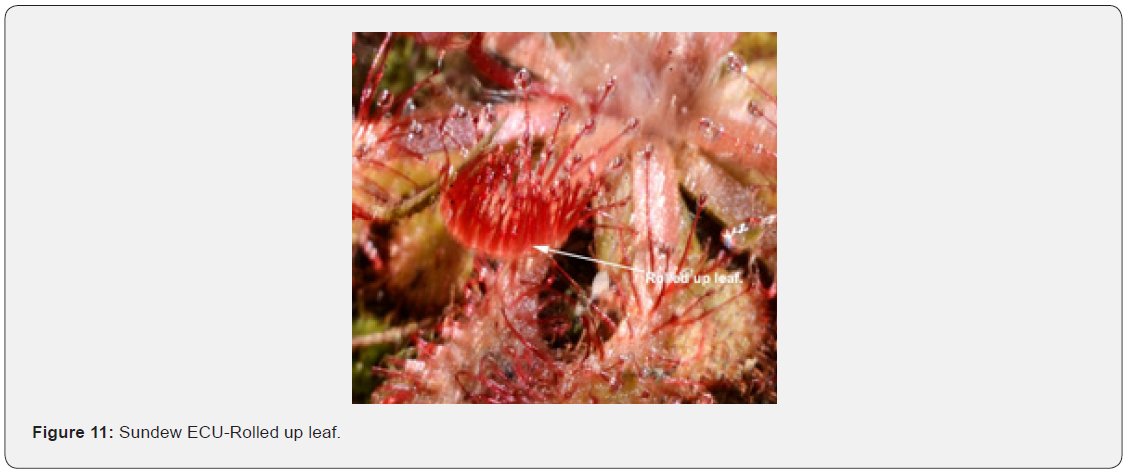

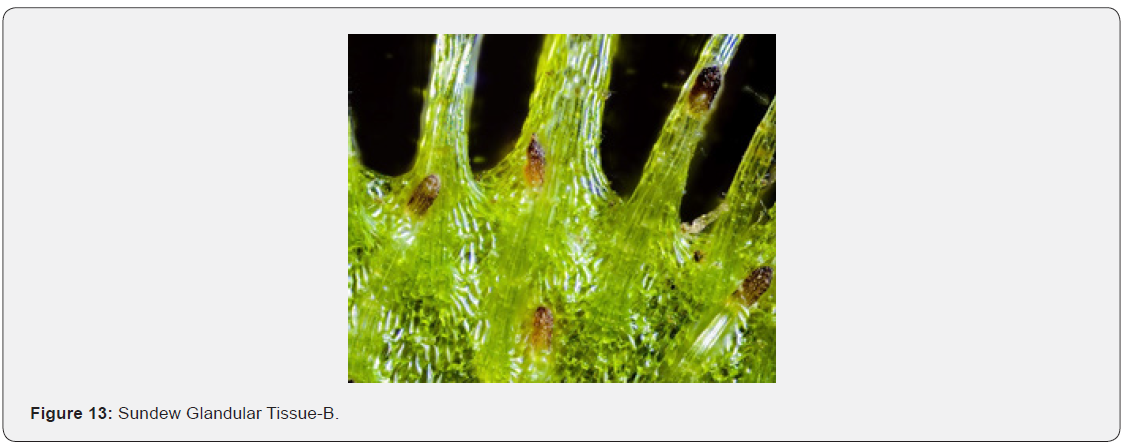
In a matter of minutes, the sundew begins to secrete digestive enzymes and acids that start to dissolve the body of the victim. A series of glands then absorb the nutritious liquefied insect. Sundews often found among pitcher plants and may grow abundantly in the many bogs of the Big Thicket. They also grow in disturbed soil and are often common along the trails and along the roadside ditches.
Small Butterwort, (Pinguicula pumila)
Small Butterwort, Pinguicula pumila, is an annual species of carnivorous plants that use sticky, glandular leaves to lure, trap, and digest insects. Many species of butterworts occur worldwide but only one is found in Texas and it is found only within the Piney Woods (Figure 14). The three-quarter inch flower of Small Butterwort grows on a stalk 6-8 inches above the plant’s basal rosette of succulent leaves. The leaf of a butterwort has a few secretory cells on top of a single stalk cell, producing a mucilaginous secretion which forms visible droplets across the leaf surface which lure prey in search of water. Once an insect contacts and is trapped on a leaf, the struggles trigger more glands to release encasing it in mucilage. Some species can roll the leaf margins slightly in response, bringing additional glands into contact with the trapped insect. Once the prey is entrapped, other glands that lie flat on the leaf surface begins the digestion process. Enzymes break down the digestible components of the insect body and the fluids are absorbed back into the leaf surface, leaving only the exoskeleton of larger insects on the leaf surface. Butterworts are very small and therefore are only able to trap small insects and those with large wing surfaces.
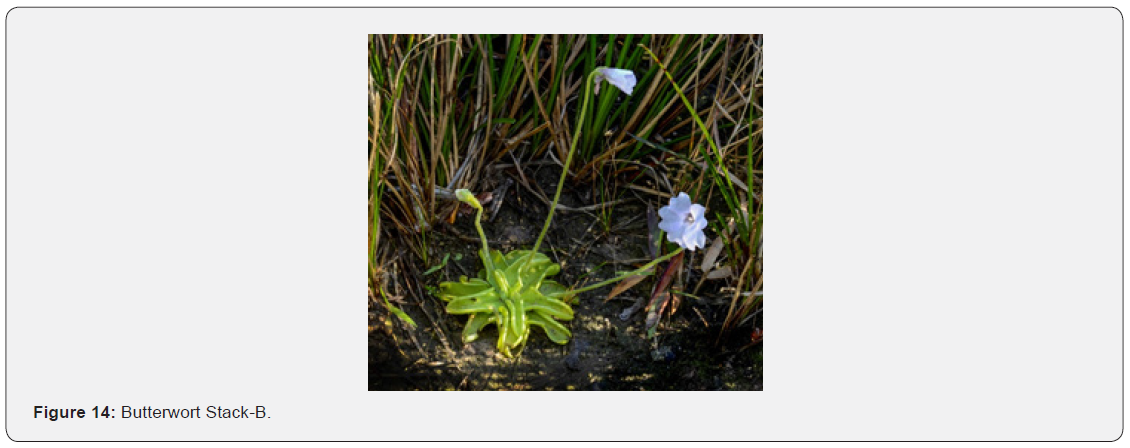
(Figure 15) The inch-and-a-half Butterwort uses hairy, sticky leaves that roll up lengthwise with an insect inside. The leaf near the bottom is partially rolled up. Nearby are several sundew plants.
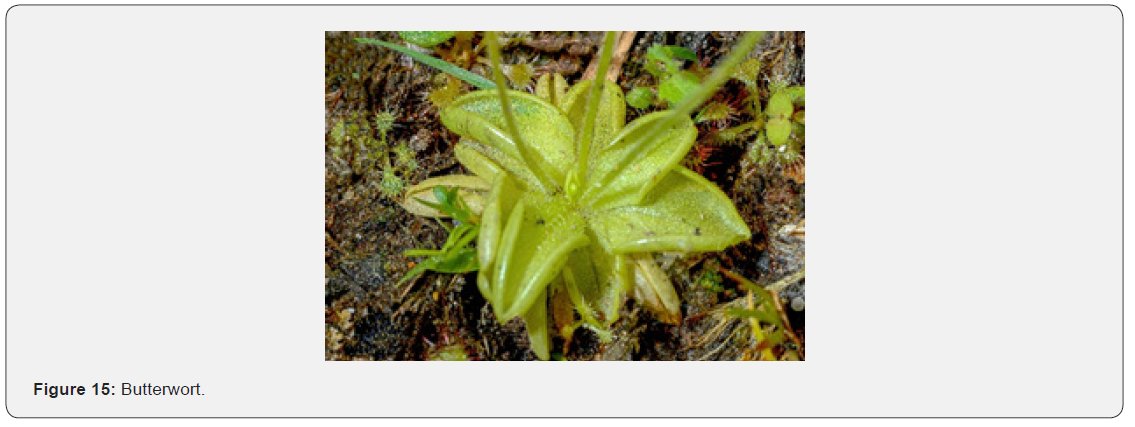
Bladderworts, (Utricularia sp.)
Bladderworts are among a large genus of carnivorous plants with over 220 species worldwide. Five species have been found in the Big Thicket, commonly in nutrient-poor bog lakes in quiet shallow, acidic waters and can form dense mats. True, free-floating bladderworts lack roots and leaves but have flowers on erect stems above the water. The entire floating plant is only about 8 inches tall. Yellowish, dime-sized flowers emerge above the surface. Underwater, the leaf stalks are fleshy and inflated with air which allows them to float. Bladderworts are unique in that the underwater leaves bear small oval “bladders” that trap and digest small aquatic invertebrates. In the open water, it supplements its nutrients by trapping insects in a bladder that is like a suction bulb. Water is expelled from the bladder by osmosis, generating a partial vacuum inside. A small, hinged trap door opening with tiny hair-like projections are sensitive to the motion of passing organisms like Daphnia (water fleas). When they are stimulated, these hairs trigger the door to open. The flattened bladder suddenly draws in water with the passing animal, closing the trap door after it when digestion begins.
(Figure 16-19) The floating Swollen Bladderwort (Utricularia inflata) has a complex below-water stem and root structure with many small air-filled sacs, or bladders. Small swollen Bladderwort (Utricularia radiata) is a plant with less complex structure and flower. As an aquatic insect touches a trigger hair near the mouth of the sac, an immediate change in internal pressure within the sac quickly pulls the insect inside to be later absorbed.

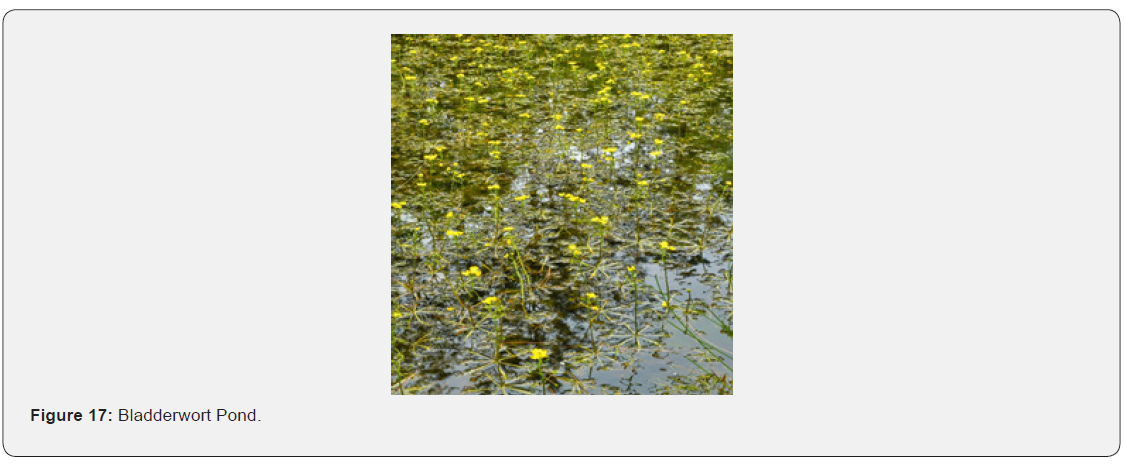
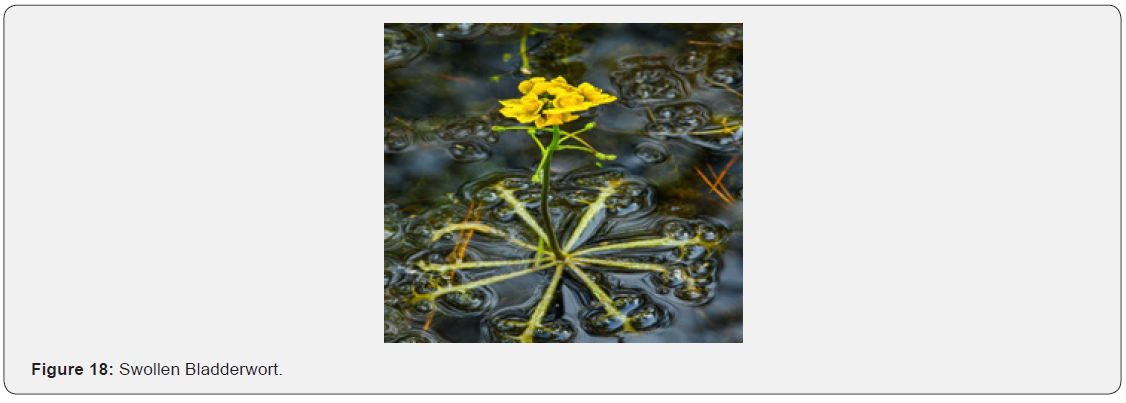
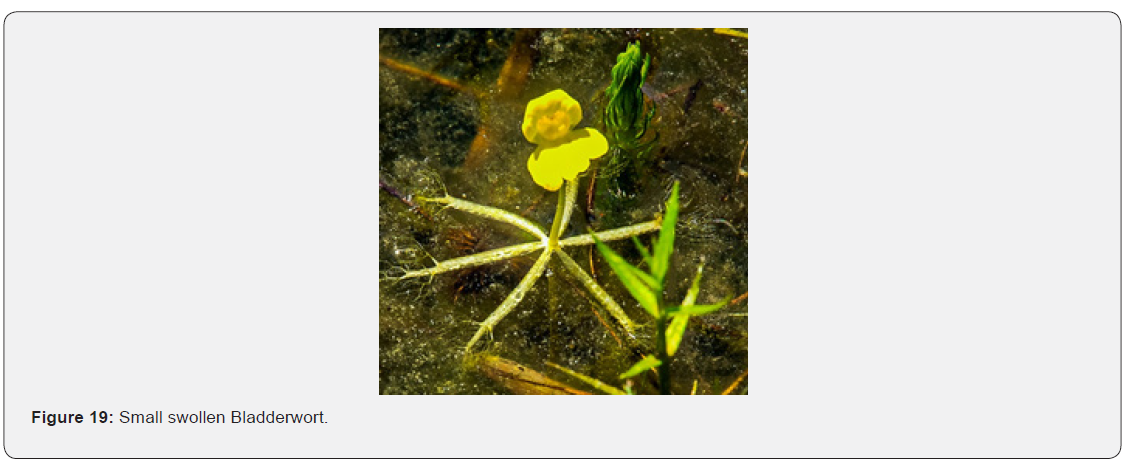

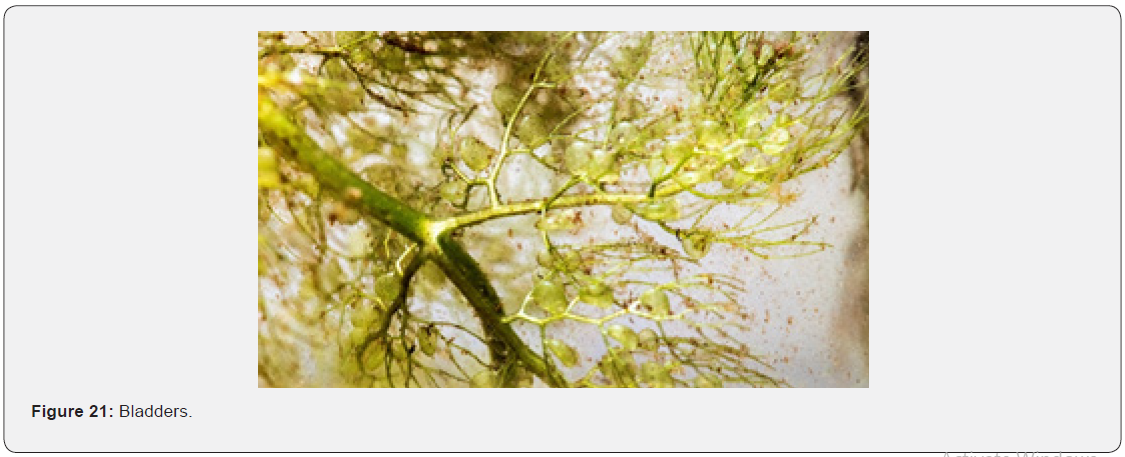
(Figure 20) Three views of the underwater structures of Bladderwort. The floating modified leaves give buoyance to the plant. The tiny, 1mm bladders can be seen throughout the modified leaves. As a small aquatic insect triggers hairs near the end of the bladder an immediate reversal of internal pressure causes the insect to be sucked in for later digestion (Figure 21 & 22).
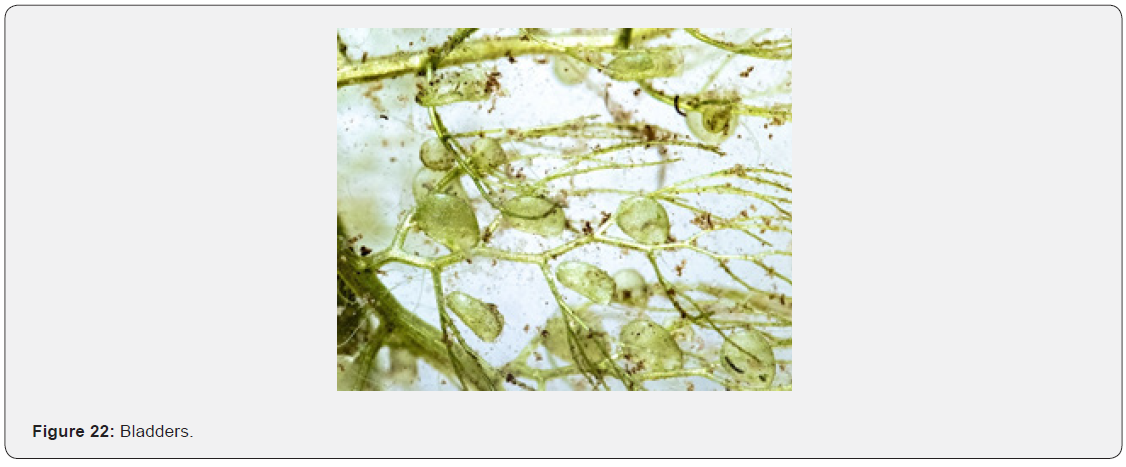
The Big Thicket Preserve
(Figure 23) The Big Thicket National Preserve is America’s first national preserve. Established in 1974, the preserve comprises nine disjointed units and encompasses about 113 thousand acres of biologically significant portions of the Piney Woods region of southeast Texas. Located near Kountze, Texas in Hardin, Polk, and Tyler Counties, this region is an area where plant species of the East Coast and Midwest reach the south and western limits of their ranges. It is a most ecologically diverse area including pine and hardwood flats, wetlands, swamps, and bottomland floodplains. All of these areas have unique plant and animal species. As the poet once wrote, “The woods are lovely, dark and deep…” is a statement with two meanings in the Big Thicket. There are many interesting and lovely things within the region like the carnivorous plants and many flowers and insects. The alamedes Swallowtailbutterfly,(PapilioPalamedes), feeding on Salvia is but one example (Figure 24). But dangers lurk as well. Diamondback rattlesnakes, (Crotalus atrox), and Copperheads (Agkistrodon contortrix) are found within most areas of East Texas. So, it is wise to watch where you walk, especially in the leaf litter where the reptiles are highly camouflaged among the detritus. The safe plan for anyone in nature is: “If you’re walking, look down; if you are looking up, stop walking!” (Figure 25). Another, but much smaller, danger is the Aedes mosquito, a species known to transmit a variety of viruses, including West Nile and Zika. Because they are water born insects, the wet ecosystem of the Big Thicket is a perfect habitat. Everyone should use plenty of repellant when outside (Figure 26) [1-11].

The Piney Woods is not dangerous. It is a region of interest, folklore, legend, and significant change. A visitor today has many recreational options: hiking, camping, bird watching and of course, photographing the wildlife and habitat within this remarkable Texas ecosystem. Much of it is public land within the Big Thicket National Preserve that is carefully conserved and protected by the National Park Service and yours to enjoy!
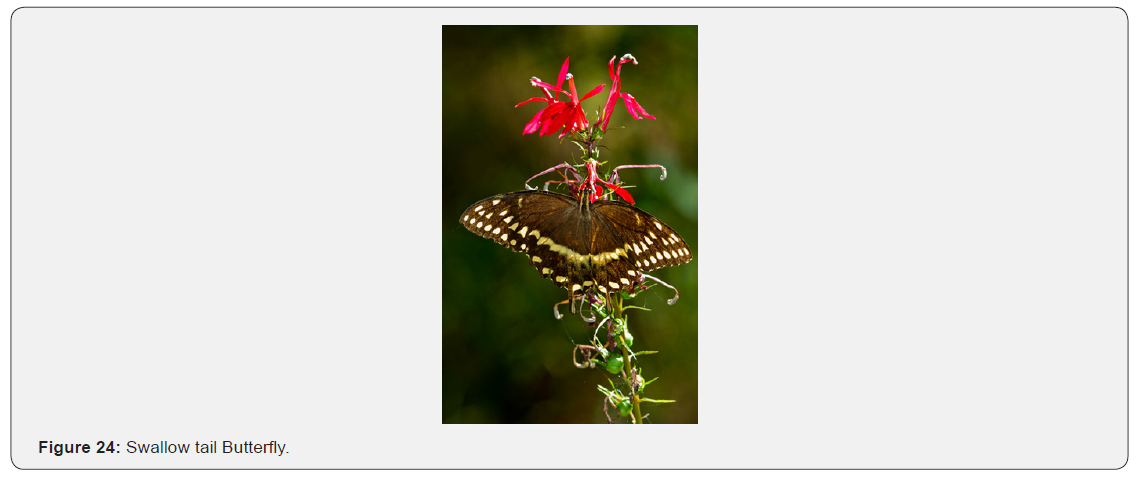
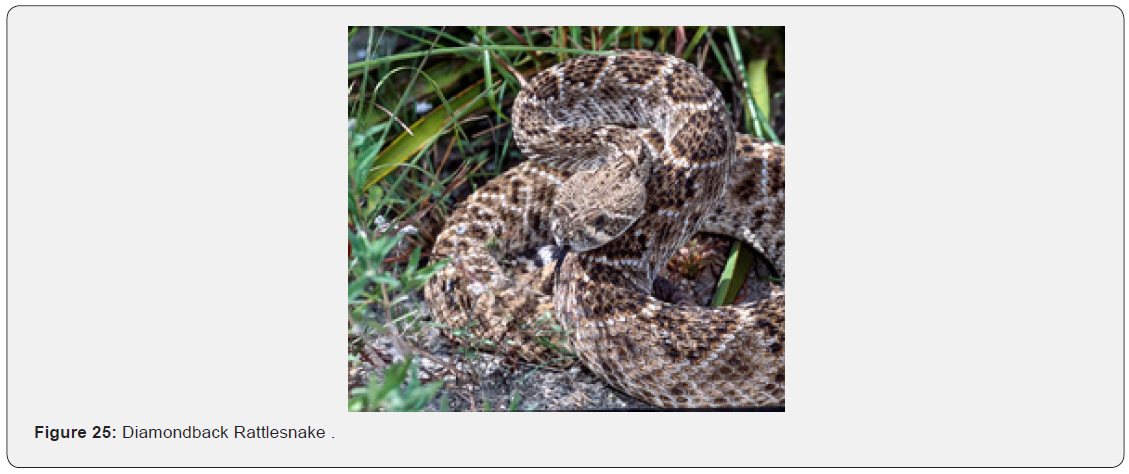
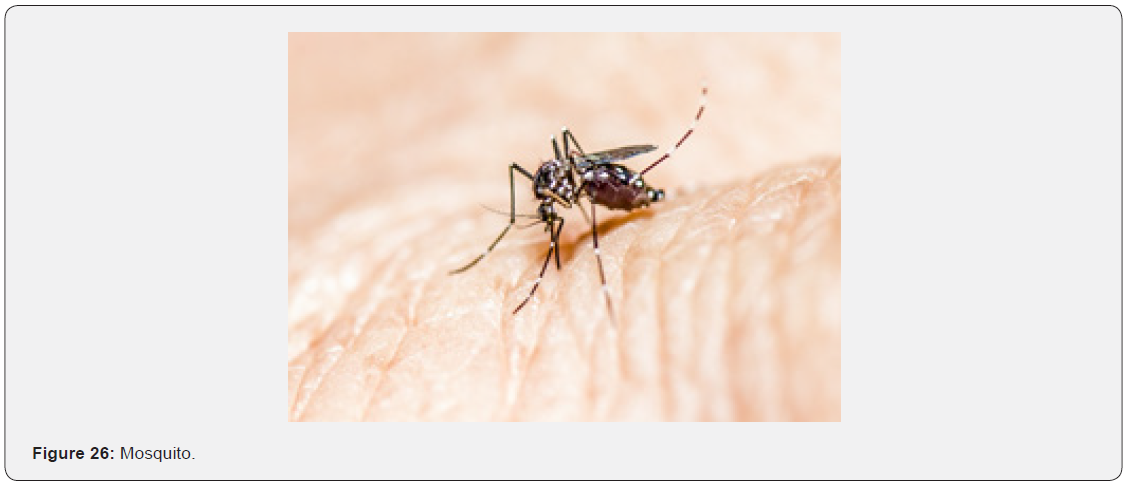
References
- Ajilvsgi, Geyata (2003) Wildflowers of the Big Thicket. Rev edn. College Station: Texas A&M University Press.
- Wildflowers of Texas (2003) Fredericksburg: Shearer Publishing.
- Darwin, Charles (1875) Insectivorous Plants. London: John Murray.
- Ellison, Aaron and Lubomir Adamec, eds (2018) Carnivorous Plants, Physiology, Ecology, and Evolution. Oxford: Oxford University Press.
- Fritz, Edward C (1986) Realms of Beauty, the Wilderness Areas of East Texas. Austin, University of Texas Press.
- Hatch, Stephan L, KN Gandhi, and Larry E Brown (1997) Checklist of the Vascular Plants of Texas. College Station: Texas A&M University Press.
- Jones, Stanley D, Joseph K Wipff, and Paul M (1997) Montgomery. Vascular Plants of Texas. Austin: University of Texas Press.
- Loflin, Brian and Shirley Loflin (2009)Texas Cacti. College Station: Texas A&M University Press.
- National Park Foundation (2020) The Big Thicket. National Park Service-U.S. Department of the Interior.
- Peacock, Howard (1994) Nature Lover’s Guide to the Big Thicket. College Station: Texas A&M University Press.
- Watson, Geraldine Ellis (2006) Big Thicket Plant Ecology. Denton: University of North Texas Press.

